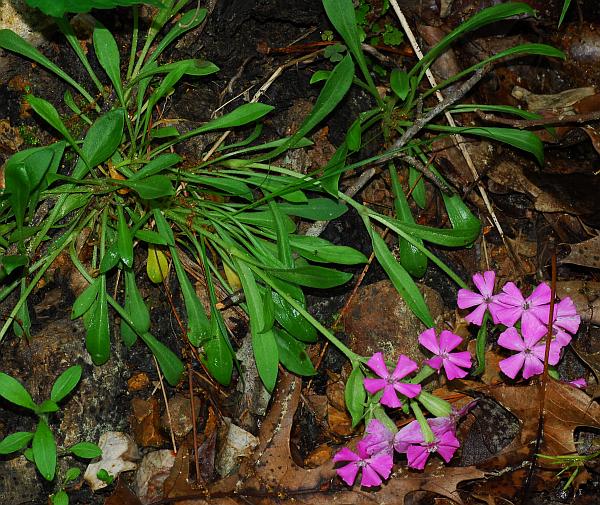Silene caroliniana Walter
Wherry's Pink

Native
CC = 9
CW = 5
MOC = 7
© SRTurner
Silene caroliniana WalterWherry's Pink | |
 |
Native CC = 9 CW = 5 MOC = 7 |
© SRTurner |
|
Family - Caryophyllaceae Habit - Perennial forb with a branched, somewhat woody rootstock. Stem - Ascending or reclining, to 20 cm, unbranched or less commonly branched, moderately to densely pubescent with soft, nonglandular hairs.
Leaves - Basal and opposite, simple. Basal leaves with a long, winged petiole. Stem leaves 2-4 pairs, sessile or nearly so, the bases fused surrounding the stem in a collar, the blades 3-9 cm long, not succulent, oblanceolate to spatulate, tapered at the base, angled to a bluntly or sharply pointed tip, glabrous except for the margins.
Inflorescences - Terminal open panicles, the stalks 0.2-0.8 cm long, densely pubescent with mostly nonglandular hairs, the bracts paired and leaflike with green margins.
Flowers - Calyx 15-22 mm long, the tube with usually 10 parallel nerves, cylindrical, becoming club-shaped at fruiting, the nerves green, pale between the nerves, densely pubescent with nonglandular hairs, the lobes oblong, green, rounded or bluntly pointed at the tip, the margins thin and white or reddish-tinged. Petals 5, 25-35 mm long, the expanded portion 9-12 mm long, entire or with wavy margins toward the tip, pink, whitish on ventral surface, with a pair of small appendages on the upper surface at the base of the expanded portion. Styles 3.
Fruits - Capsules 9-12 mm long, dehiscing apically by 6 teeth, with a basal stalklike portion 5-8 mm long. Seeds 1.3-1.5 mm wide, kidney-shaped, the surface with minute papillae, reddish brown. Flowering - April - May. Habitat - Mesic forests on rocky slopes, bluffs, usually on acidic substrates. Origin - Native to the U.S. Lookalikes - None close. Other info. - For rich, saturated color it is hard to beat the flowers of this species. The plant is relatively uncommon in Missouri, known only from the central Ozark region. Elsewhere the distribution is peculiar, apparently comprising three relatively small, disjunct populations. In addition to Missouri's, a second population is located in Alabama, and the third occupies eastern Kentucky and parts of Ohio and West Virginia. Most authors have recognized three infraspecific forms, with Missouri's being var. wherryi. The other varieties, var. pensylvanica and var. caroliniana, both have glandular hairs on the calyces. Photographs taken near the Big Piney Campground, Texas County, MO, 5-13-2019 (SRTurner). |